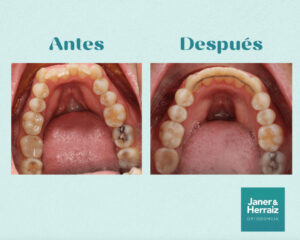Crowded teeth are a type of dental malocclusion (deviation from what we call “normal occlusion or bite”). It is considered a normal dental problem that can occur at any age. However, it is during adolescence when the most severe crowding occurs, which is why it is one of the most frequent reasons for visits to the orthodontic office.
We define crowding as the reduction in the perimeter of the dental arch (where the teeth rest) causing a dental overlap where the teeth are crowded together due to lack of space, usually occurs in the area of the incisors (these are the 4 teeth we have in the upper arch and lower in the middle) that are out of place.
It is very common to have crowding in the lower arch especially in the incisor area. Moderate crowding can occur in both upper and lower arches. It is necessary to correct it to allow the teeth to be aligned correctly and avoid future problems.
Incisors are key to have a healthy and beautiful smile, so crowding is one of the most typical reasons in consultation. It is not only important to have a beautiful smile but also a healthy one, if we solve the crowding it is much easier to maintain a good oral hygiene and therefore avoid future problems.
Most common causes of crowded teeth
Dental crowding can be caused by a number of factors, many of which are related to genetics and development during childhood. The most common causes of crowded teeth include:
- Eruption of wisdom teeth.
- Genetics. If parents have crowded teeth, it is likely that their children will also have crowded teeth.
- Gum disease.
- Age. As we age our jaws lose density and as they change shape it causes dental crowding.
- Cleft lip or cleft palate.
- Tooth and jaw size. Discrepancies between the size of the teeth and the space available in the jaw can cause crowding. Large teeth in a small jaw do not have enough space to align properly.
- Thumb sucking or frequent pacifier use after the age of three.
- Accidents and premature loss of baby teeth.
- To be an oral respirator.
- Supernumerary teeth. The presence of extra teeth can cause lack of space and crowding.
Consequences of dental crowding
Dental crowding can have several aesthetic and functional consequences. Some of the main consequences are:
- Oral hygiene problems. Crowded teeth can be more difficult to clean properly, which increases the risk of plaque and tartar buildup. This can lead to tooth decay, gum disease (gingivitis and periodontitis) and bad breath.
- Dental wear. Teeth that are misaligned can wear unevenly causing tooth sensitivity and other long-term problems.
- Bite problems. Dental crowding affects the way the upper and lower teeth align with each other when biting.
- Pain and discomfort. Misalignment of the teeth can cause tension in the jaw muscles, which can result in headaches, jaw pain and problems opening or closing the mouth.
- Aesthetic problems. Dental crowding can affect the appearance of the smile and self-confidence.
- Difficulty in speech. In some cases, misaligned teeth can interfere with the correct pronunciation of certain sounds, which can affect speech.
- Increased risk of injury. Prominent or misaligned teeth are at increased risk of fracture or injury, especially in trauma or accident situations.
Invisible orthodontics as a solution for crowded teeth
The ideal age to visit your orthodontist is between 8 and 10 years old, since it gives us a margin to be able to act and prevent future problems.
If your teeth are healthy and you like your shape and color, invisible orthodontics is the best option to correct your crowded teeth. The choice of treatment depends on the severity of crowding and the specific needs of the patient. Depending on the severity, treatment can last between 9 and 18 months. If you wear retainers after treatment, your smile will last a lifetime.
Do not hesitate to contact our team of orthodontists specialized in invisible orthodontics to discuss your case.
Below is a before and after photo of one of our patients with lower crowding treated at the Janer&Herraiz clinic with invisible orthodontics:
Does invisible orthodontics correct severe dental crowding?
Yes, invisible orthodontics can correct any type of crowding whether it is moderate or severe. Invisible orthodontics is effective in cases with severe crowding, but it is crucial that an orthodontist specializing in invisible orthodontics with aligners evaluates the severity of the crowding and plans the treatment correctly. At Janer&Herraiz we have specialists with more than 20 years of experience and more than 1500 cases treated with invisible orthodontics.
Advances in clear aligner technology have expanded their ability to treat more complex cases. However, in situations of severe crowding, supplemental treatments such as tooth extraction may be necessary to gain more space and allow teeth to be properly positioned.
Finally, patient compliance is very important to ensure treatment success. The effectiveness of invisible orthodontics also depends on patient compliance. Aligners should be worn at least 22 hours a day and changed as directed by the orthodontist.



